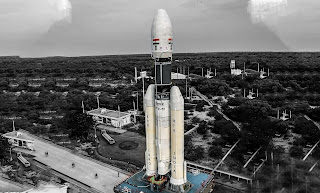Unveiling the Phases of Chandrayaan-3: A Comprehensive Journey of Lunar Exploration
Chandrayaan-3, the highly anticipated lunar exploration mission by the Indian Space Research Organisation (ISRO), entails a series of meticulously planned phases that aim to advance scientific knowledge and pave the way for further space exploration. This article provides a detailed analysis of the various stages encompassing the extensive mission of Chandrayaan-3.
Phase 1: Pre-Launch Preparations The mission commences with a rigorous phase of pre-launch preparations, where a team of dedicated scientists, engineers, and technicians collaborate to ensure the spacecraft's readiness for its voyage to the Moon. This phase involves an array of tasks, including spacecraft assembly, integration of scientific instruments, and thorough system-level testing to guarantee optimal performance.
 |
| Chandrayaan-3 |
Phase 2: Launch and Trans-lunar Injection Following the preparatory phase, Chandrayaan-3 embarks on its journey through the launch vehicle, propelling it into space. The launch phase involves a precisely calculated trajectory to achieve the desired orbit around the Earth. Once in the Earth's orbit, the spacecraft executes a trans-lunar injection maneuver, which imparts the necessary velocity to escape Earth's gravitational pull and commence the lunar journey.
Phase 3: Lunar Transfer Trajectory In this crucial phase, Chandrayaan-3 undertakes a carefully calculated lunar transfer trajectory to reach the vicinity of the Moon. This trajectory involves a series of course corrections and mid-course maneuvers to ensure precise navigation and alignment with the lunar sphere of influence.
Phase 4: Lunar Capture and Orbit Insertion Upon reaching the lunar vicinity, the spacecraft executes a critical lunar capture maneuver, which enables it to be captured by the Moon's gravitational field. Subsequently, Chandrayaan-3 performs an orbit insertion maneuver to achieve the desired lunar orbit. This phase demands high precision to ensure that the spacecraft attains the desired altitude and inclination necessary for subsequent scientific exploration.
Phase 5: Lunar Surface Probing Having successfully entered the lunar orbit, Chandrayaan-3 commences its primary objective of conducting comprehensive surface probing activities. This phase involves deploying sophisticated scientific instruments, such as high-resolution cameras, spectrometers, and seismometers, to collect valuable data about the lunar terrain, mineral composition, and geological characteristics. The acquired data aids in enhancing our understanding of the Moon's origin and evolution.
Phase 6: Communication and Data Transmission Throughout the mission, efficient communication between the lunar spacecraft and ground stations is essential. Chandrayaan-3 employs a reliable communication system to transmit scientific data, images, and other mission-related information back to Earth. This phase involves the utilization of sophisticated antenna systems, data processing algorithms, and ground station networks to ensure seamless communication and data retrieval.
Phase 7: Mission Completion and Post-Mission Analysis Upon the completion of the surface probing activities, Chandrayaan-3 concludes its primary mission objectives. The spacecraft then enters a phase of post-mission analysis, where the acquired data undergoes comprehensive scrutiny by a team of scientists and researchers. This analysis aims to extract valuable insights, further scientific knowledge, and develop future space exploration strategies.
Phase 8: Technology Demonstrations and Experiments In addition to its primary scientific objectives, Chandrayaan-3 also serves as a platform for technology demonstrations and experiments. This phase involves testing and validating new technologies and techniques that can be utilized in future space missions. These experiments may include advancements in propulsion systems, communication technologies, and autonomous navigation capabilities, among others. By pushing the boundaries of technological innovation, Chandrayaan-3 contributes to the advancement of space exploration on a broader scale.
Phase 9: Resource Exploration and Utilization One of the key objectives of Chandrayaan-3 is to explore and assess the availability of lunar resources for potential utilization in future space missions. This phase involves the deployment of instruments and sensors capable of detecting and analyzing lunar resources such as water ice, minerals, and other valuable materials. By understanding the distribution and characteristics of these resources, Chandrayaan-3 plays a crucial role in facilitating future lunar resource exploration and utilization.
Phase 10: Collaborative International Efforts Chandrayaan-3 is not only an endeavor by the Indian Space Research Organization but also represents an opportunity for international collaboration in lunar exploration. This mission encourages partnerships with other space agencies, institutions, and researchers from around the world. Collaborative efforts may include sharing scientific data, jointly conducting experiments, and leveraging expertise and resources to achieve common goals. Through international cooperation, Chandrayaan-3 fosters a global community focused on advancing our understanding of the Moon and expanding the boundaries of human knowledge.
Phase 11: Public Outreach and Education The mission of Chandrayaan-3 extends beyond scientific and technological achievements. It also aims to inspire and engage the public, particularly students and aspiring scientists, in the wonders of space exploration. This phase involves educational outreach programs, public lectures, and interactive initiatives designed to ignite curiosity and foster a passion for space science. By promoting scientific literacy and awareness, Chandrayaan-3 contributes to the development of a scientifically informed and inspired society.
Conclusion: The multi-phase mission of Chandrayaan-3 not only encompasses scientific exploration and technological advancements but also emphasizes international collaboration and public engagement. Through its extensive journey, Chandrayaan-3 lays the groundwork for future lunar missions, contributes to the understanding of our cosmic neighborhood, and inspires the next generation of scientists and explorers. With each phase carefully planned and executed, Chandrayaan-3 stands as a testament to the ingenuity and determination of the global space community in unraveling the mysteries of the Moon.





.jpeg)
Comments
Post a Comment